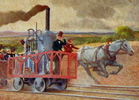 |
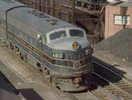 |
Across Maryland History: |
|---|
| This is a test alteration: 02/07/15. We have just passed the 180th anniversary years of the Baltimore and Ohio Railroad, the first railroad in America to carry both passengers and freight over long distances. The B&O was conceived in 1827, begun in 1828 and was operational with horse-drawn trains in 1829. It took 25 years of construction along the Patapsco, Potomac and other rivers to reach Ohio. Many bits of infrastructure, mostly bridges, built in those early days survive and are still used by the B&O's successor, CSX. In 1835, the B&O became the first railroad to serve Washington, DC. In the early 1870s, the line familiar to Montgomery Countians running through Silver Spring, Kensington, Garrett Park (named for the B&O president who built it), Rockville and Gaithersburg was built to connect Washington with the main line going West. Below: some B&O pictures and lore that I've collected over three decades. |
 |
| Above is an early 1950s photo of the B&O's Mount Clare Station at Pratt and Poppleton Sts. in Baltimore. This building is the world's oldest railroad station, built 1830. Through it, in 1844, passed the wires that carried the first telegraph message in the world ("What hath God Wrought?") sent from Baltimore to the U.S. Capitol. In front is the "Altantic," of 1832, one of the B&O's first steam locomotives, a miraculous survivor. It is typical of earliest steamers, with a vertical boiler, no shelter for the engineer and drive rods that inspired the nickname, "grasshopper." Even though the Atlantic became obsolete design-wise shortly after it was built, it was used to push cars around Mount Clare for sixty years, long enough for its historical value to be recognized. It can be seen today in the B&O R.R. Museum. |
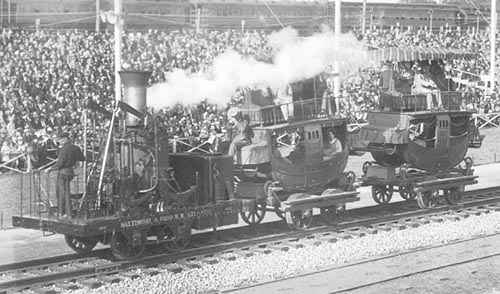 |
| And here is a very rare photo of the Atlantic in operation. This was taken in Halethorpe, MD, at the Fair of the Iron Horse, celebrating the B&O's Centennial in 1927. Note the early double-decker passenger cars, really stagecoaches with train wheels. Note also the riders on the upper decks getting blasted with steam. These primitive wood-burning engines spewed glowing hot cinders that could set passengers' clothes on fire. It wasn't long before filtered, balloon-shaped smokestacks and closed passenger cars were developed. |
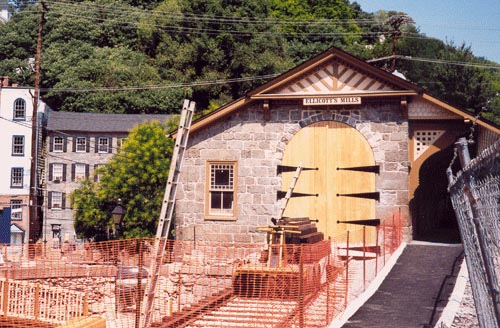 |
| B&O construction reached Ellicott's Mills (now Ellicott City) in 1831 when the station shown here was built. I took this photo during a restoration which brought back the double doors leading to a loco garage for the early grasshopper engines. During the restoration, the remains of a long-buried and forgotten turntable pit (seen behind the ladder) were discovered. |
 |
| Here we have the great race that never happened as depicted by Harold Stitt in one of a series of scenes he painted for the B&O's centennial. Legend had it that one day in 1829, inventor Peter Cooper was testing his locomotive "Tom Thumb" on the B&O line when along came a horse-pulled train. A challenge was made, a race begun. The Tom Thumb lost to the horse when the little engine broke down, ha, ha. First of all, the B&O in 1829 only had one track; two trains could not be raced side by side. Secondly, a racing horse would have beaten any engine of the time. They only went 5-10 mph. |
 |
| Thirdly an 1829 horse would have been frightened to a frenzy by a locomotive. Here we see a conception of a scene along the C&O canal. The canal company very reluctantly shared the east bank of the Potomac with the B&O. I don't know how much fist-shaking there was, but there certainly was a lot of legal wrangling over canal/railroad rights of way between Point-of-Rocks and Harpers Ferry. |
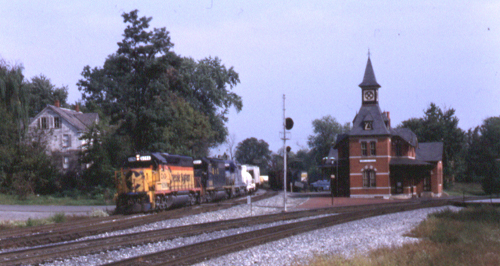 |
| Point-of-Rocks, shown here in the Chessie System days, is the spot where the B&O came alongside the Potomac River. It is also the junction where the original line from Baltimore met the Metropolitan Division line coming from Washington, DC by way of Silver Spring, Rockville etc. The Point-of-Rocks station, built in 1873 along with the line from DC, has become an icon of railroad architecture. There should be no surprise when I tell you that it was designed by a church architect. |
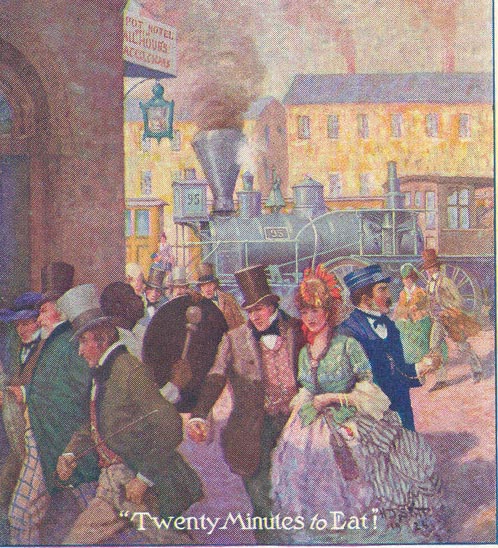 |
| In the primitive days of railroading, there were no dining and sleeping accomodations on trains. They stopped at mealtime and at night. Passengers could be summoned back aboard the trains by someone blowing a horn or yelling through a megaphone. The song I've Been Working On The Railroad goes back to these very early times. We can tell because of the obtuse verse about Dinah blowing her horn--or rather being late to blow her horn because she was making out in the kitchen. |
 |
| A rare old photo of Harpers Ferry taken after the Civil War. Throughout this conflict, the B&O was in a precarious position as it ran right along the Union-Confederate lines. Strange/Funny story: Confederate Stonewall Jackson occupied Harpers Ferry in 1861, yet for a month, did nothing about B&O trains passing through laden with coal and other materials for the Union war effort. Then some Johnny Reb said "Wait a minute...!" Stonewall wised up, began disrupting B&O operations, burning and looting trains, commandeering engines for the Confederacy. The CSA also blew up the original bridge across the Potomac. The one in the picture above was an innovative iron replacement built by the B&O's bridge engineer, Wendell Bollman. In the foreground, under the bridge, is the C&O Canal and towpath. Only the pilings of the Bollman's Harpers Ferry bridge remain. But, believe it or not, one Bollman's other poneer bridges still survives. It is the one shown below located at Savage Mill, MD, near Laurel. |
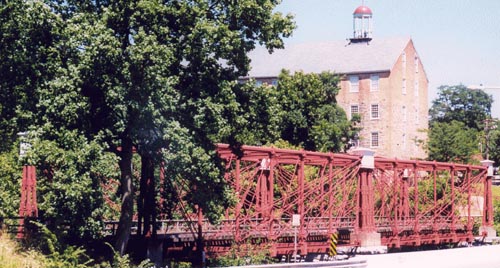 |
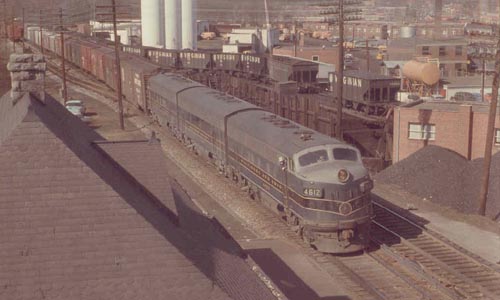 |
| And here is the B&O in Brookland, DC, at the height of the diesel era. This 1950s photo was taken from the Michigan Ave. bridge. The roof at left is the Brookland r.r. station where the Brookland-CUA Metro station is now located. In the background is the Brooks' coal yard. |
If you haven't had enough, see also: The B&O's 180th Anniversary: The B&O in Western PA, 1966 Across Maryland History: The B&O Railroad's Early Days Building For The Ages: The B&O and C&O along The Potomac Change For The Better: The B&O Transportation Museum My 70s Show: A Teenager's Amateur Photos of Washington, DC and Maryland Railroads, 1974-1977 |